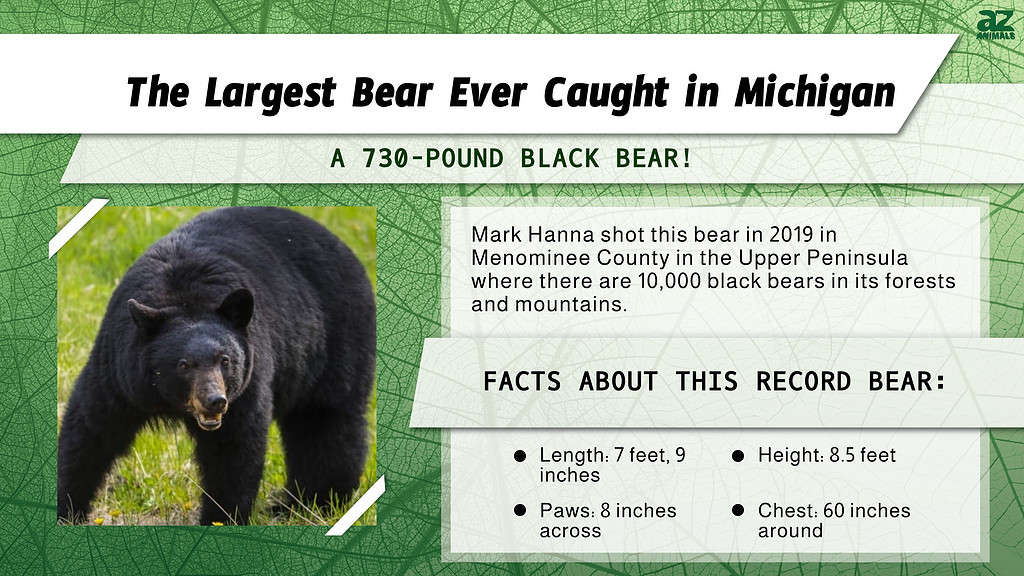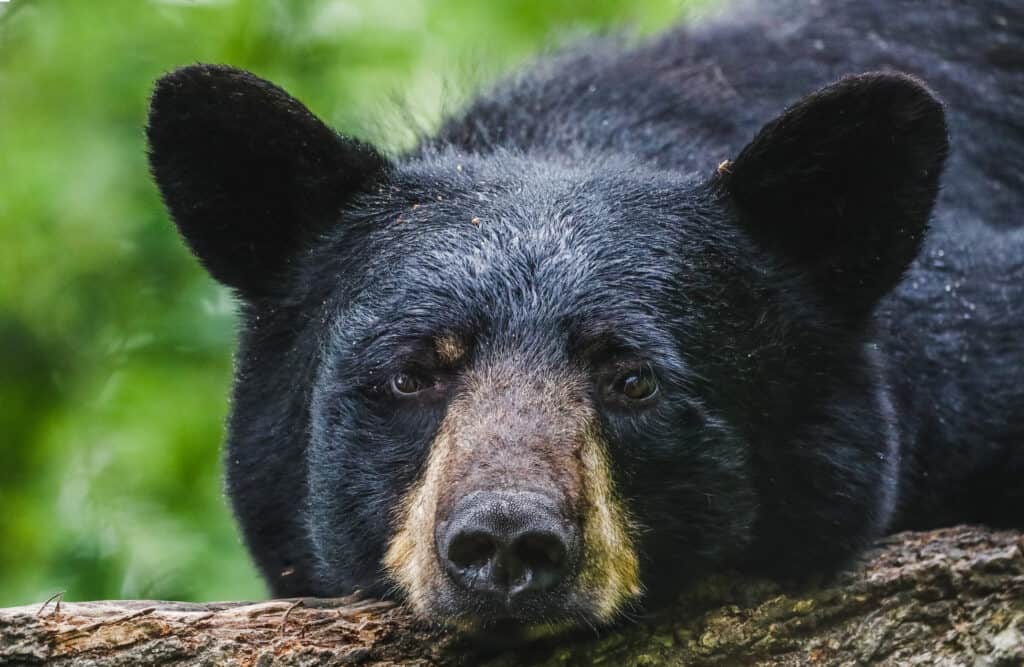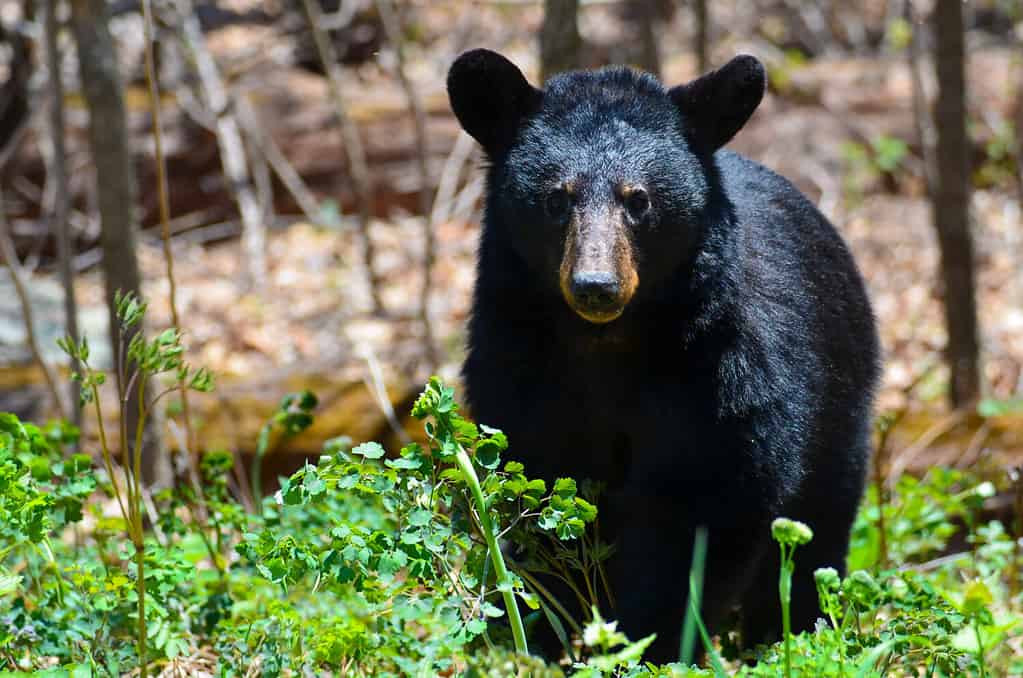Known as the Great Lake State, Michigan is a beautiful state bounded by giant lakes. The dense forests and rugged mountains of the Upper Peninsula make the ideal habitat for wildlife, including a fair number of black bears. Every year, hunters venture out into the state’s wild landscape to hunt these magnificent predators. Keep reading to discover the largest bear ever caught in Michigan!

The largest bear ever caught in Michigan was a black bear killed by Michigan resident Mark Hanna. On the evening of September 25, 2019, Hanna bagged a gigantic bruin while hunting in Menominee County on the Upper Peninsula. From nose to tail, the bear measured 7 feet, 9 inches long, and 8.5 feet tall when mounted. Its front paw measured 8 inches across, while its chest measured 60 inches in circumference. With a live weight of 730 pounds and a dressed weight of 640 to 650 pounds, the enormous bruin ranks as one of the heaviest bears in the Michigan history books.
Hanna first spotted the bruin on a game camera near one of his bear baits on August 20th, 2019. The bear remained in the vicinity over the following month, which allowed Hanna to track its movements. He baited a spot on private land that the bear frequented each day with cereals and nuts. Michigan law permits the use of bait barrels for bear hunting on private land. It also allows their use on state land so long as the barrels are within 100 yards of a forest road and anchored to the ground. Hanna waited in a ladder stand south of the spot for several days until he could get the perfect shot. Southerly winds foiled his efforts for several days as the bear kept catching his scent. Several other smaller bears visited the bait barrel, but Hanna remained patient, refilling the barrel each day.
On the morning of September 25th, the wind finally came in from the west, and Hanna went to his ladder stand. At around 6:30 in the morning, he heard the bear coming toward the bait barrel. The bear roared loudly, likely to warn other bears in the area to stay away from the bait. Hanna sighted the bear and shot it from 25 yards out with a 225-grain Nosler bullet from a .340 Weatherby rifle. The bullet hit the bear behind the shoulder, right in the middle of his body. Despite the hit, the bear managed to run 150 yards before it collapsed and expired.
Prior to Hanna’s kill, the heaviest Michigan bear on record was bagged by Herb Mitchell from South Haven, Michigan. Mitchell shot a bear in November 1950 in Iron County on the Upper Peninsula. That bear had a dressed weight of 650 pounds, making it close in size to Hanna’s bear, although its live weight is unknown. The bear Hanna shot may have grown even larger as it continued to put on weight for winter. If he waited a few more weeks, the bear surely would have measured even larger.
Black Bear: Types and Appearance

Most black bears have a thick, black coat, but it can look dark brown, grayish-blue, blond, or cinnamon.
©Mark Caunt/Shutterstock.com
Today, the only bears that live in Michigan are American black bears (Ursus americanus). The other two bear species in North America – the grizzly bear (Ursus arctos) and polar bear (Ursus maritimus) – are not historically found in Michigan.
As their name implies, most black bears possess a thick, black coat. That said, their coat can also look dark brown, grayish-blue, blond, or cinnamon. However, these other color varieties appear more often in western North America and rarely occur in Michigan. People sometimes refer to larger black bears as “bruins,” from the Old English term for a brown bear.
On average, adult black bears stand 3 feet tall at the shoulder and measure 3 to 5 feet from nose to tail. Males usually measure larger than females, and weights vary depending on the time of year. In Michigan, a typical female black bear can range from 90 to 300 pounds, while males range between 130 and 500 pounds.
Black Bear: Habitat

Black bears in Michigan live in the mountainous and forested areas of the Upper Peninsula.
©iStock.com/Mandy Fuller Photography
You can find American black bears throughout much of North America. In the United States, most black bears live in the northeastern and western parts of the country, with some smaller populations in the southeastern and northern states. Canada possesses the greatest concentration of black bears on the continent, although you can also find them in some regions of Mexico.
Over 83% of black bears in Michigan live in the mountainous and forested areas of the Upper Peninsula. The forests of the Upper Peninsula provide the bears with the cover and food they need to survive. However, bears are highly adaptable, and they can thrive in other habitats, including coniferous swamps, grasslands, and riparian zones. Presently, more and more bears continue to move south into Michigan’s Lower Peninsula in search of food. This means you may encounter them more often in croplands, orchards, campsites, and around human refuse.
How Many Black Bears Are There in Michigan?
According to estimates, approximately 12,000 black bears currently live in Michigan. Of this total, around 10,000 live in the Upper Peninsula, while 2,000 live in the Lower Peninsula. The bear population fell to a low of about 1,300 in 2011 due to overhunting and accidental deaths. However, stricter regulations and reduced hunting licenses allowed the black bear population to slowly recover. Meanwhile, the total North American population of black bears numbers around 800,000. Given its widespread distribution, the IUCN lists the American black bear as a species of Least Concern.
Is It Legal to Hunt Bears in Michigan?

It is legal to hunt the American Black Bear in Michigan depending on the season and location.
©Orhan Cam/Shutterstock.com
Early settlers to Michigan treated bears as pests, which led to the widespread killing of bears. Black bears remained unprotected in the state up until 1925, when the Michigan legislature officially declared black bears as game animals. Up until then, you did not need a license to hunt bears in Michigan. Hunting bears with bait has always been legal in the state, and in 1939 the government made it legal to hunt bears with dogs. It has been illegal to hunt bear cubs in Michigan since 1948. Starting in 1995, authorities made it illegal to kill a female bear with cubs. Additionally, you cannot trap bears in Michigan unless you receive a special permit from the state.
Today, the Michigan Department of Natural Resources controls the hunting of black bears in the state. The Natural Resources Commission possesses the power to open or close bear hunting season and determine how hunters can take bears. The timing and length of the season can vary depending on the number of available adult bears. In the Upper Peninsula, bear hunting season typically starts in early September and ends in late October. The hunting season in the Lower Peninsula is even shorter, typically only one week in September and October. In 2021, approximately 60,772 people applied for 7,001 licenses to hunt black bears in Michigan. With those licenses, around 1,300 bears were killed, most of them in the Upper Peninsula. Licenses may be bought in the Upper Peninsula, while licenses in the Lower Peninsula are usually obtained via a raffle.
Are Black Bears Dangerous?
Like all wild animals, black bears can pose a danger to humans. While most tend to avoid humans, they can act aggressively if cornered or provoked. Most bear encounters occur when people come between a bear and its food. Female bears with cubs may also charge or threaten people to protect their cubs. Bears that live near human settlements may also lose their fear of people over time. This can lead to increased contact with humans and increases the likelihood of a dangerous confrontation. When camping, you should also make preparations to secure your food. Never leave food out in the open, and make an effort to secure trash cans with bear-proof containers. You should never attempt to feed a wild bear or make contact with one.
If you encounter a bear in the wild, you should attempt to stand your ground. Face the bear directly and try to make yourself look as big as possible. Wave your arms or a sweater and make loud noises while you slowly back away. If the bear comes toward you, do not turn your back or run away. A bear can run much faster than a human and climb exceptionally well. Pick up any small children with you and also leave any backpacks or bags on, as they can provide protection in case the bear decides to attack. Ideally, you should carry bear mace to ward off any bears you encounter in the wild. While bears are dangerous, they rarely, if ever, attack humans. On average, black bears kill less than 1 person per year in the US.
Conclusion
The largest bear caught in Michigan was a 730-pound monster bruin, but most bears in Michigan measure much smaller than that. You’re much more likely to be killed by a deer than a bear, so there’s no need to fear a random bear attack.
The photo featured at the top of this post is © iStock.com/Brittany Crossman
Sources
- Bear Hunting Magazine, Available here: http://www.bear-hunting.com/bear-baiting?ID=3390cad6-cef9-4063-9693-6329ee8d4457
- Michigan Department of Natural Resources , Available here: https://www.michigan.gov/dnr/things-to-do/hunting/bear/about-black-bears-in-michigan
Thank you for reading! Have some feedback for us? Contact the AZ Animals editorial team.






